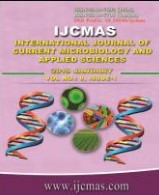


 National Academy of Agricultural Sciences (NAAS)
National Academy of Agricultural Sciences (NAAS)

|
PRINT ISSN : 2319-7692
Online ISSN : 2319-7706 Issues : 12 per year Publisher : Excellent Publishers Email : editorijcmas@gmail.com / submit@ijcmas.com Editor-in-chief: Dr.M.Prakash Index Copernicus ICV 2018: 95.39 NAAS RATING 2020: 5.38 |
In the present study, the integrated use of different sources of nitrogen was used to estimate the growth and yield of pearl millet. The field experiment was conducted at Agronomy farm, of S.K.N. College of Agriculture, Jobner (Rajasthan) during kharif season 2017 in loamy sand soil. The experiment was laid out according to factorial randomized block design with three replications. The experiment comprised eight treatments of sources of nitrogen (Control, 50% RDN through urea + 50% RDN through vermicompost, 50% RDN through urea+ 50% RDN through FYM, 75% RDN through urea+ 25% RDN through vermicompost, 75% RDN through urea + 25% RDN through FYM, 100% RDN through urea, 100% RDN through vermicompost and 100% RDN through FYM) and two treatments of biofertilizer (without inoculation and with Azotobacter) were applied to the pearl millet variety RHB-173. The RDN was 60 kg N. The application of sources of nitrogen significantly increased plant height, dry matter accumulation, number of effective tillers, grains per ear, test weight, grain and Stover yield, under 75% RDN through urea+ 25% RDN through vermicompost and seed inoculation with Azotobacter significantly increased plant height, dry matter accumulation, number of effective tillers, grains per ear, test weight, grain and stover yield.
 |
 |
 |
 |
 |